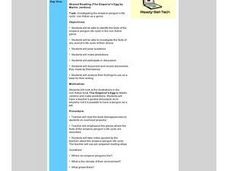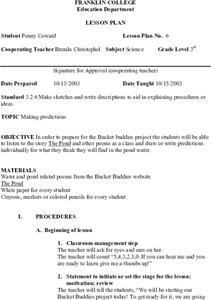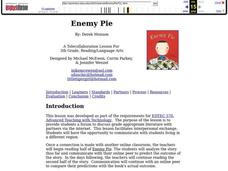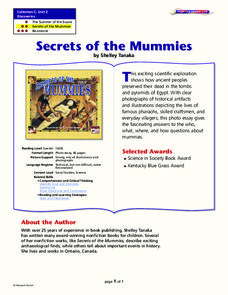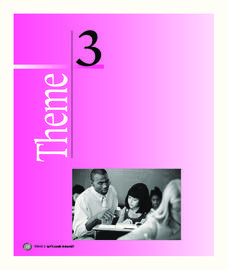Curated OER
Predicting Based on Character Relationships
Students read a book. In this making predictions lesson, students learn how to make a prediction in a story and discover how character relationships can help in their predictions. Students read a story stopping to make predictions.
Curated OER
Hatchet: Predicting the Outcome Guide
What will happen in Hatchet by Gary Paulsen? Kids read a series of possible events that will occur in the novel and mark whether they agree or disagree with the probability of each event happening.
Guam Community College
Joseph Had a Little Overcoat
Spruce up a class reading of the children's book Joseph Had a Little Overcoat by Simms Taback with this fun series of activities. Starting with a list of reading comprehension questions and key vocabulary to address during a teacher read...
Curated OER
You Can’t Judge a Book by Its Cover… But Can You Judge a Book by Its First Line?
In this literary prediction worksheet, learners predict the topic, genre, setting, characters, and interest level of a book based on its first line. They research the title and author of the book using the line. They write a short story...
Curated OER
You Can't Judge a Book By Its Cover... But Can You Judge a Book By Its First Line?
In this literature/book analysis worksheet, students read and think about the first sentence of a book which is provided. Based on this first sentence, students answer 6 questions, making predictions about what the book will be like....
Curated OER
The Emperor's Egg by Martin Jenkins
Students explore the penguin life cycle. For this penguin life cycle lesson, students read the book The Emperor's Egg by Martin Jenkins. Students look at the pictures and make predictions. Students identify facts about penguins and do...
Curated OER
Sink or Float?
Learners make and test predictions about sinking and floating, and classify objects according to whether they sink or float.
Curated OER
The Rest of the Story
Third graders make predictions about the story "The True Story of the Three Little Pigs" based on background knowledge. They read the story, stopping to verify or reject predictions. They write their own opinionated fairytales.
Curated OER
A Is For America
Students listen to the story A Is For America and make predictions before reading and recall details after reading. In this America lesson, students listen to this story and learn important facts about America.
Curated OER
Book Report
In this book report worksheet, students fill in their book's title, author, illustrator, and characters, beginning, middle, and end. Students also write a personal connection, a prediction, and their opinion of the book.
Houghton Mifflin Harcourt
Surprise!: Challenge Activities (Theme 2)
Surprise! is the theme of this series of challenge activities. The surprise comes from the information your scholars will discover when researching topics such as alligators and crocodiles, living in other countries, becoming a...
Curated OER
Making Predictions
Third graders develop predictions in preparation for a "Bucket Buddies" pond water project. They listen to the book "The Pond" and discuss the different life forms in the pond from the book. Students then read online poems, and draw a...
Curated OER
Prediction Using On-Line Stories!
Fifth graders analyze the elements of an online story. In this online story lesson, 5th graders analyze the title, pictures, and other information for an online story. Students predict what the text is about and complete a prediction chart.
Curated OER
The Seed Match
Students examine seeds and predict the plant it comes from. In this seed match lesson, students match seeds to plants and then see if their predictions are correct. Students predict the number of seeds found in plants as well. Students...
Curated OER
Enemy Pie
Third graders pair up with a partner via an online classroom. They analyze half of the story "Enemy Pie" and communicate with their online peer to predict the outcome of the story.
Curated OER
Secrets of the Mummies
How did the ancient people of Egypt preserve their dead so well that their bodies are still recognizable today? Learn the painstakingly complex process they used for preservation. Young scholars read and summarize a narrative detailing...
Curated OER
Read Between the Lines
Build comprehension, inference, and conclusion skills by encouraging learners to see the importance of reading between the lines.
Curated OER
Using Pictures to Make Story Predictions
In this literacy and literature activity, students choose a book to read with a home reading partner. They write down the name of the book and its author. They examine the cover and the book's pictures before writing a prediction about...
Curated OER
Out of the Dust: DR-TA
Encourage good reading habits with an activity that asks class members to examine the title and cover of Out of the Dust, and then make predictions about the setting of and events in the tale.
Houghton Mifflin Harcourt
Three Skeleton Key
Encourage your learners to interact with the text as they read. While reading "Three Skeleton Key," class members note predictions, define words and study their meanings, take notes on how the suspense builds, and jot down ideas about...
Curated OER
My Antonia: Directed Reading Thinking Activity
Walk your pupils through the beginning of My Antonia by Willa Cather with a read-aloud-style activity. The goal is to make predictions and back them up with textual evidence.
Curated OER
Rosencrantz and Guildenstern Are Dead: DR-TA Strategy
Making predictions is an excellent reading strategy. Work on building this into your pupils' toolkit of strategies by trying out the process outlined here for reading the very beginning of Rosencrantz and Guildenstern Are Dead. The...
Houghton Mifflin Harcourt
Let’s Look Around!: Challenge Activities (Theme 3)
Let's Look Around! is the theme of a unit that offers a plethora of challenge activities. Enhance your scholars' learning experiences and reinforce concepts with activities such as writing a book about farm animals, an imaginary place,...
Curated OER
Introduce: Cause and Effect
Introduce beginning readers to cause and effect in a story by exploring it together. Learners make predictions about a book based on its cover, title, and a brief flip through the pages. They listen to an explanation of cause and effect...







